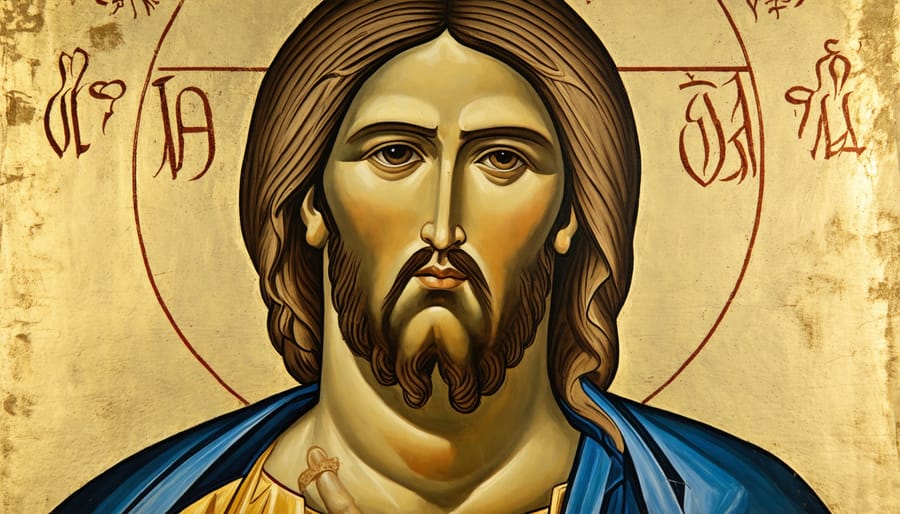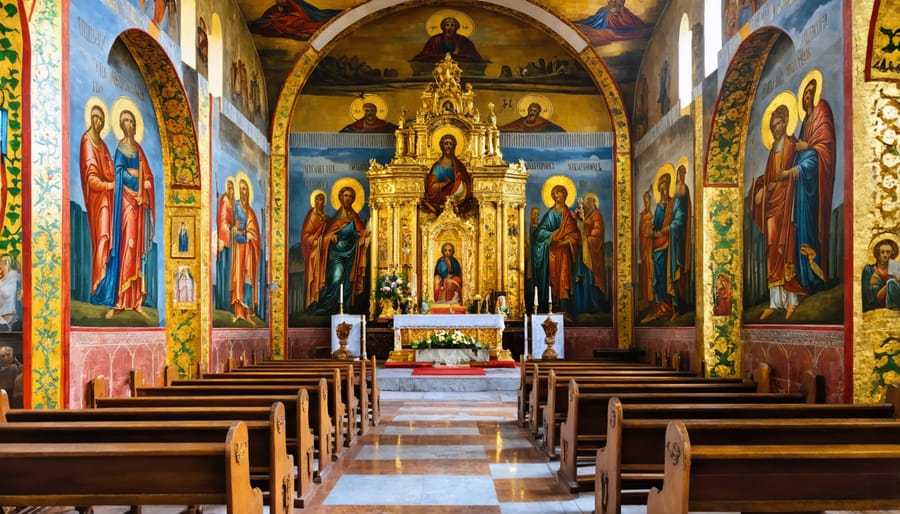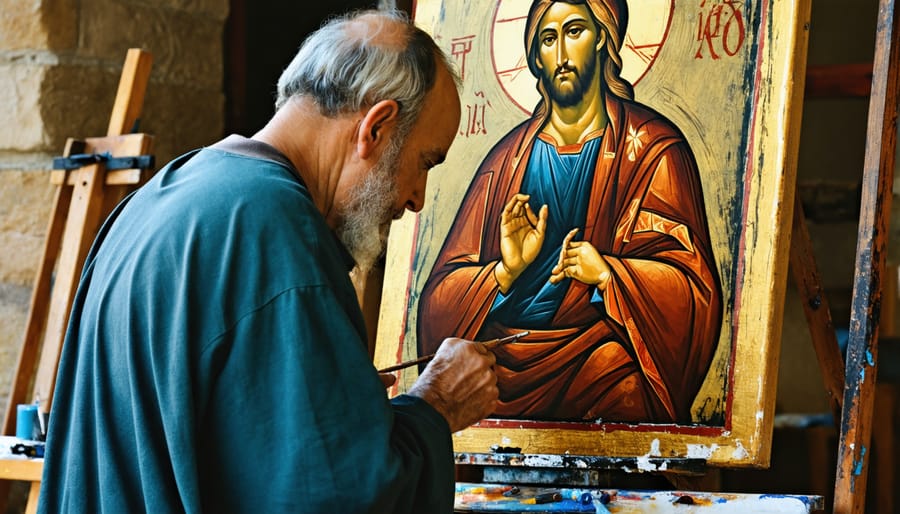Orthodox Christian art stands as one of the most profound expressions of faith ever created, transcending mere decoration to become a spiritual window into the divine. For over two millennia, these sacred images have served as both theological declarations and devotional tools, bringing heaven’s mysteries closer to earth through brilliant colors, intricate symbolism, and masterful technique.
Icons, mosaics, and frescoes within Orthodox churches transform ordinary spaces into glimpses of the celestial realm, where gold leaf catches light like divine sparks and figures gaze with timeless intensity at worshippers across centuries. Each artwork adheres to strict canonical traditions while simultaneously expressing the unique cultural heritage of Orthodox communities from Greece to Russia, Ethiopia to Serbia.
This artistic tradition represents far more than aesthetic achievement – it embodies the Orthodox understanding of God’s incarnation and humanity’s potential for transfiguration. Every brushstroke, every carefully chosen color, and every compositional element serves to proclaim the Gospel through visual theology, creating what the Church Fathers called “windows to heaven.”
As we explore Orthodox Christian art, we discover not just a historical artistic movement, but a living tradition that continues to inspire contemporary sacred artists and speak to modern hearts seeking authentic spiritual expression through beauty and truth.
The Divine Purpose of Orthodox Christian Art
Icons as Windows to Heaven
In Orthodox Christianity, icons serve as more than mere artistic representations; they are considered sacred windows through which believers glimpse the divine realm. Building upon the biblical foundations of religious art, these holy images create a bridge between heaven and earth, inviting the faithful into deeper communion with God.
Icons are written, not painted – a distinction that emphasizes their role as visual scripture. Each element, from the golden halos symbolizing divine light to the reversed perspective drawing viewers into the sacred scene, carries profound theological meaning. The serene faces of Christ, the Virgin Mary, and the saints reflect the transfigured state of those who dwell in God’s presence.
When Orthodox Christians venerate icons through prayer and contemplation, they’re not worshiping the physical materials but rather directing their devotion through the image to the holy person depicted. This practice, rooted in the doctrine of the Incarnation, affirms that since God became visible in Christ, sacred images can serve as channels of divine grace and presence in our world today.

Beyond Decoration: The Liturgical Function
In Orthodox Christianity, art transcends mere aesthetic appeal to become an integral component of worship and spiritual practice. Icons, frescoes, and mosaics serve as windows to heaven, creating sacred spaces that facilitate a deeper connection with God. These artistic elements are not simply decorative additions but are considered essential tools for prayer, meditation, and spiritual formation.
During Orthodox services, believers engage with these sacred images through prayer and veneration, understanding them as channels of divine grace. The placement of icons and other artistic elements within the church follows a carefully planned theological program, designed to guide worshippers through their spiritual journey. The iconostasis, for example, serves as a bridge between heaven and earth, while dome frescoes depicting Christ Pantocrator remind believers of God’s sovereignty and presence.
Orthodox art also functions as a form of catechesis, teaching biblical stories and church doctrine through visual representation. For those who couldn’t read in earlier times, these images served as “books for the illiterate,” conveying profound theological truths through color, composition, and symbolism. Today, they continue to serve as powerful aids in spiritual formation, helping believers contemplate divine mysteries and deepen their faith through visual meditation.
Key Elements of Orthodox Christian Art

Sacred Symbolism and Color
In Orthodox Christian art, sacred symbols in Christian art carry deep spiritual significance, each carefully chosen to convey theological truths and enhance worship. The use of color plays an equally important role, with each hue bearing specific spiritual meaning.
Gold, predominant in Orthodox icons, represents divine light and God’s eternal glory. It reminds believers of heaven’s radiance and Christ’s majesty. Blue symbolizes heaven and the mystery of divine life, often seen in the Virgin Mary’s garments, while red represents Christ’s humanity and sacrificial blood. White, expressing purity and divine light, appears in resurrection scenes and feast day celebrations.
Common symbols include the circle, representing eternity and God’s endless nature, while the cross stands as the central symbol of salvation. The lamb symbolizes Christ’s sacrifice, and the dove represents the Holy Spirit’s presence. Halos around saints’ heads indicate their participation in God’s divine light, while raised hands signal blessing and prayer.
These artistic elements aren’t merely decorative but serve as windows to heaven, helping believers connect with divine truths. Through these carefully chosen colors and symbols, Orthodox art creates a sacred space where the earthly and heavenly realms meet, inviting worshippers into deeper contemplation of God’s mysteries.
Artistic Techniques and Traditions
Orthodox Christian art follows time-honored techniques and traditions that have been preserved through generations of faithful artisans. The creation of icons, the most recognizable form of Orthodox art, involves a deeply spiritual process that begins with prayer and fasting. Artists, known as iconographers, traditionally use natural materials such as wood panels, egg tempera, and precious minerals to create these sacred images.
The technique of icon writing (as it is called, rather than painting) follows specific canonical rules. Every color holds symbolic meaning: gold represents divine light, red signifies divine life, and blue represents human life. The reverse perspective technique, where lines converge toward the viewer rather than away, is deliberately used to draw the faithful into the spiritual realm.
Frescoes, another important form of Orthodox art, are created using wet plaster and natural pigments. This demanding technique requires swift execution and deep knowledge of how colors will appear once the plaster dries. Medieval Orthodox churches often feature entire walls covered in these intricate frescoes, telling Biblical stories and depicting the lives of saints.
Mosaics, created with tiny pieces of colored glass or stone called tesserae, represent another significant artistic tradition. These lasting works often adorn church domes and apses, creating stunning visual effects as light plays across their surfaces. Each piece is carefully placed to create sacred images that have inspired worshippers for centuries.

Cultural Impact Through the Ages
Historical Preservation of Faith
Orthodox Christian art has served as a vital conduit for preserving and transmitting the faith through generations, acting as a visual testament to sacred traditions and biblical truths. These artistic expressions have functioned as “windows to heaven,” enabling believers across centuries to connect with divine mysteries through visual representations of holy narratives and sacred figures.
The preservation of Orthodox artistic traditions has been particularly remarkable through the practice of icon writing, where techniques and symbolic elements have been carefully passed down from master to apprentice. This transmission ensures that each new generation of artists maintains the authentic spiritual essence and theological accuracy of Orthodox imagery while adhering to established canonical forms.
Through times of persecution and cultural shifts, Orthodox art has remained steadfast in its role as a keeper of sacred memory. During periods when written texts were scarce or literacy was limited, these visual representations served as “books for the illiterate,” helping to maintain the continuity of Orthodox teaching and worship practices.
The tradition continues today, with contemporary Orthodox artists learning from historical examples while creating works that speak to modern believers. This living tradition demonstrates how Orthodox art remains both timeless and relevant, preserving ancient truths while fostering spiritual growth in each new generation of the faithful.
This artistic heritage not only preserves theological truths but also maintains the spiritual practices and devotional attitudes that have characterized Orthodox Christianity throughout its history. Through careful adherence to traditional forms and methods, Orthodox art continues to serve as a bridge between past and present, ensuring that the faith’s rich spiritual legacy endures for future generations.
Modern Cultural Resonance
Orthodox Christian art continues to resonate powerfully in contemporary culture, extending far beyond its traditional religious contexts. Its enduring influence on Western culture can be seen in various modern artistic expressions, from gallery exhibitions to digital media.
Today’s artists frequently draw inspiration from traditional Orthodox iconography, incorporating its distinctive stylistic elements into contemporary works. This revival manifests in both sacred and secular spaces, with Orthodox-inspired imagery appearing in modern church designs, public murals, and even digital art platforms.
The minimalist movement has found particular resonance with Orthodox artistic principles, appreciating its focus on essential forms and spiritual meaning over realistic representation. Many contemporary artists are drawn to the contemplative nature of Orthodox art, using its techniques to explore themes of spirituality, identity, and human connection in our fast-paced world.
Social media platforms have also contributed to a renewed interest in Orthodox Christian art, with countless artists sharing their icon-inspired works and traditional techniques with global audiences. This digital renaissance has made Orthodox artistic traditions more accessible to younger generations, fostering a deeper appreciation for its spiritual and aesthetic values.
Modern Orthodox artists continue to create traditional works while also exploring new mediums and interpretations, demonstrating how ancient artistic practices can remain relevant and meaningful in contemporary spiritual expression. This ongoing dialogue between tradition and innovation ensures that Orthodox Christian art remains a living, breathing tradition that speaks to modern hearts and minds.
Appreciating Orthodox Art Today
Visiting Orthodox Churches
When visiting an Orthodox church to experience its sacred art, it’s important to approach with reverence and respect for both the space and its worshippers. Before entering, check if photography is permitted, as many churches have specific guidelines about capturing images of their sacred artwork. If allowed, avoid using flash photography, which can damage delicate paintings and disturb worshippers.
Dress modestly when visiting Orthodox churches; women are often expected to cover their heads and shoulders, while men should remove hats. Many churches provide scarves or wraps at the entrance for visitors to use. Remember that these are active places of worship, not museums, so maintain a quiet, respectful demeanor.
Take time to observe the iconostasis, the wall of icons that separates the nave from the sanctuary. Notice how the icons are arranged in specific tiers, each telling part of the Christian story. While admiring the artwork, be mindful not to touch the icons, as they are considered sacred objects of veneration.
If services are in progress, stand quietly at the back of the church or follow the congregation’s movements if you feel comfortable. This provides an opportunity to see how Orthodox Christians interact with the artwork during worship, adding depth to your understanding of these sacred images.
Consider visiting during off-peak hours when fewer worshippers are present. Many Orthodox churches offer guided tours or have knowledgeable staff who can explain the symbolism and significance of different artistic elements. Don’t hesitate to ask questions, but do so at appropriate times and in a respectful manner.
Remember that each piece of Orthodox church art serves a spiritual purpose beyond its aesthetic value, connecting believers to the divine through sacred imagery and ancient traditions.
Personal Spiritual Connection
Incorporating Orthodox Christian art into your personal faith journey can profoundly deepen your spiritual experience. The transformative power of sacred art lies in its ability to create moments of contemplation and connection with God.
Begin by setting aside a quiet space in your home for an icon corner or prayer area. This sacred space can feature carefully chosen icons that resonate with your spiritual journey. As you pray, let the images guide your meditation, remembering that these works serve as windows to heaven rather than objects of worship themselves.
Consider starting each day with a few minutes of peaceful contemplation before an icon, allowing its symbolism and beauty to draw you into prayer. Many believers find that keeping a spiritual journal about their experiences with Orthodox art helps deepen their understanding and emotional connection to the sacred images.
You might also incorporate Orthodox artistic elements into your Bible study routine. When reading Scripture, pause to observe how related icons interpret the passage visually. This practice can offer fresh insights and bring biblical narratives to life in meaningful ways.
Join or form a study group focused on exploring Orthodox Christian art. Sharing observations and experiences with fellow believers can enrich your appreciation while building community. Remember that engaging with sacred art is not about artistic critique but about opening your heart to divine truth and beauty.
Through patient practice and reverent attention, Orthodox Christian art becomes more than mere decoration—it transforms into a vital tool for spiritual growth and closer communion with God.
Orthodox Christian art stands as a timeless testament to the profound relationship between faith and artistic expression. Through centuries of devotion and creativity, this sacred art form has served not only as a window into heaven but as a bridge connecting generations of believers to their spiritual heritage. The distinctive characteristics of Orthodox iconography – from its reverse perspective to its use of divine light and symbolic colors – continue to inspire both faithful practitioners and art enthusiasts alike.
The enduring influence of Orthodox Christian art extends far beyond church walls, enriching global cultural heritage and providing spiritual nourishment to countless souls. Its emphasis on depicting the divine through carefully prescribed canonical forms has preserved essential theological truths while simultaneously allowing for subtle artistic evolution within tradition. This beautiful balance between preservation and renewal demonstrates how Orthodox art remains vibrantly relevant in our contemporary world.
Today, Orthodox Christian art continues to fulfill its original purpose: to draw believers into deeper communion with God and to teach the faith through visual theology. Whether adorning ancient cathedrals or contemporary prayer corners, these sacred images serve as silent witnesses to the transformative power of divine grace. Their lasting significance lies not only in their artistic merit but in their ability to inspire devotion, facilitate prayer, and remind us of the sacred presence in our midst.
As we look to the future, Orthodox Christian art remains a vital expression of faith that speaks to hearts across cultural and denominational boundaries, inviting all to contemplate the mysteries of divine love and human transformation through Christ.
